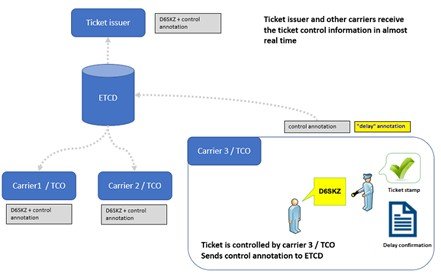1/25
The goal for 2025: digitalisation of the Agreement on Journey Continuation (AJC)
The goal for 2025: digitalisation of the Agreement on Journey Continuation (AJC)
The digitalisation of the Agreement on Journey Continuation (AJC) marks a significant step in simplifying processes for both passengers and railway companies. This milestone will streamline operations, making journey continuation more efficient and passenger-friendly by introducing a fully digital delay confirmation.
From harmonisation to digitalisation
Before moving towards digitalisation, a crucial milestone was achieved with the harmonisation of the CIT delay confirmation, as reported in the previous edition of CIT News. This uniform delay confirmation, approved by the CIV Committee in 2023, laid the foundation for a digital transformation. Standardising this process ensured that all railway undertakings would use the same format for confirming delays and cancellations, reducing inconsistencies and improving efficiency. However, in an increasingly digital world, the next logical step was to move from paper-based confirmations to a digital system.
Implementing the digital delay confirmation
In cooperation with UIC, CIT has worked on the digital delay confirmation based on the Electronic Ticket Control Database (eTCD), as technically described in the UIC IRS 90918-4 specification. A key feature of this solution is digital annotation, which allows the ticket control organisation (TCO) to register and access real-time information on ticket validity, changes in itinerary, and electronic annotations, including delay annotations. This means passengers will no longer need to request a paper confirmation, and train staff can access up-to-date travel data directly in the system.
To achieve this, CIT has collaborated closely with UIC’s technical working groups to develop a business case, define user scenarios, and ensure smooth integration into the existing ticketing infrastructure. The technical solution was formally adopted by UIC in late 2024 and has been in production since January 2025, following a testing phase. One of the key aspects of this implementation is ensuring that each ticket with a delay confirmation is correctly identified in the eTCD, even when multiple tickets (contracts of carriage) are involved in an AJC journey.
Next steps for railways
With the technical implementation completed on the UIC side, the focus now shifts to railway undertakings (RUs). The success of AJC digitalisation depends on the effective application of eTCD and the delay annotation by RUs. This requires not only technical adaptations but also internal process adjustments to fully integrate digital delay confirmations into railway operations. In parallel, amendments to the AJC agreement will be introduced by CIT to align with these digital developments.
The goal is clear: the implementation of digital delay confirmation is a key requirement of the CER Ticketing Road Map.

